Italy’s gastronomic heritage is a tapestry woven with history, reflecting a diverse array of culinary traditions that have evolved over centuries. Influenced by various cultures and time periods, Italian cuisine is a true testament to the rich and varied history of the country.
Key Takeaways:
- Italian cuisine has a rich and diverse history, encompassing influences from ancient Rome, the Etruscans, Arab Muslims, and the Renaissance period.
- Pasta, one of Italy’s most famous foods, has its roots in the Etruscans and was influenced by the Greeks and Arabs.
- The introduction of spices and fruits from the Arab Muslim occupation in Sicily during the Middle Ages added a new dimension to Italian cuisine.
- The Renaissance period brought a wave of new ingredients from the New World, such as tomatoes, zucchini, and chocolate.
- The unification of Italy in the 19th century led to the blending of regional flavours and the creation of the diverse Italian cuisine we know today.
Ancient Roman Influences on Italian Cuisine
The journey through Italy’s culinary past begins in the ancient city of Rome, where the foundations of Italian cuisine were laid. Influenced by various cultures and conquered lands, the ancient Romans incorporated a wide array of ingredients and spices into their dishes, shaping the traditions that continue to shape Italian cuisine to this day.
The Romans were known for their love of food and extravagant banquets. They brought in new flavours and culinary techniques from their conquests, incorporating ingredients such as olive oil, honey, and garum (a fermented fish sauce) into their dishes. The Roman Empire’s vast trade network also introduced spices like cinnamon, cumin, and coriander, adding depth and complexity to their cuisine.
To truly understand the impact of ancient Roman cuisine on Italy, one must explore the culinary techniques that are still prevalent today. The art of making pasta, for example, can be traced back to ancient Rome, where it was a staple food. The Romans perfected the art of making macaroni-like pasta, which they would cook and serve with various sauces and toppings.
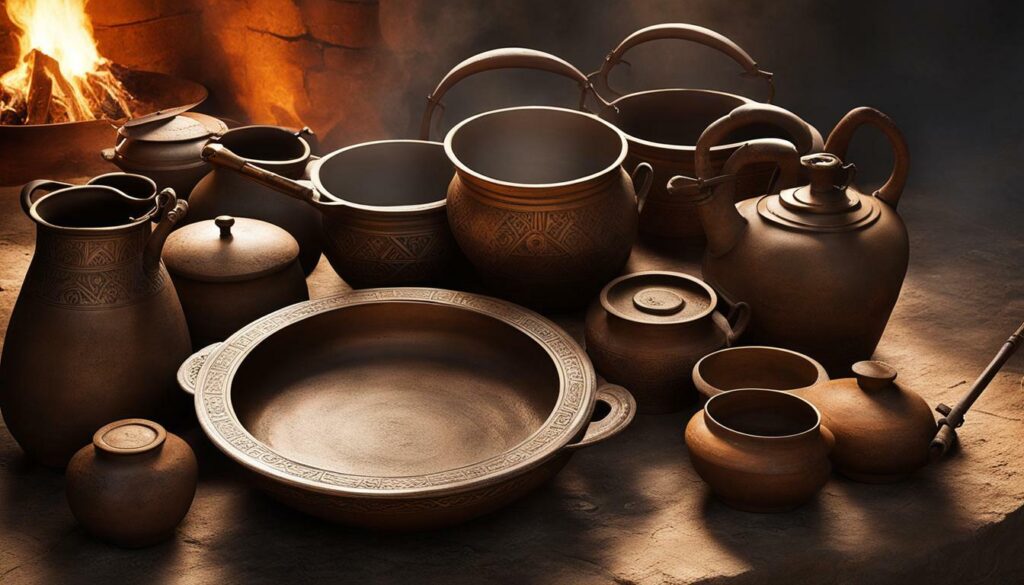
One cannot discuss ancient Roman cuisine without mentioning the influence of Apicius, one of the first recorded Roman gourmet chefs. His cookbook, “De re Coquinaria,” provided insights into the elaborate and innovative dishes of the time, showcasing the Roman dedication to culinary excellence. Recipes such as patinae (savoury custards) and condituram (marinades) offer a glimpse into the unique flavours and techniques that shaped Italian cuisine.
| Ancient Roman Influences | Modern Italian Cuisine |
|---|---|
| Olive oil | Used in various Italian dishes, such as bruschetta and pasta sauces |
| Garum | Inspired the use of fish-based sauces, such as colatura di alici |
| Spices | Introduced a taste for complexity, seen in dishes like carbonara |
| Pasta | A cornerstone of Italian cuisine, prepared in numerous shapes and styles |
The ancient Roman influences on Italian cuisine are undeniable. From pasta to olive oil, the flavours and techniques developed during this era have laid the groundwork for the rich culinary heritage that Italy is known for. Exploring the origins of Italian cuisine allows us to appreciate the diversity and depth of flavours that continue to tantalize palates all over the world.
The Etruscans and the Birth of Pasta
One cannot discuss Italian cuisine without mentioning the Etruscans, who introduced the cornerstone of Italian gastronomy – pasta. This ancient civilization, which flourished in Italy before the rise of the Roman Empire, played a significant role in shaping Italian cuisine as we know it today. The Etruscans were skilled farmers, cultivating wheat and grains that were the basis for making pasta.
The Etruscans’ innovative techniques in pasta-making set the foundation for the wide variety of pasta dishes we enjoy today. They were the first to use water to cook pasta, a practice that continues to be followed centuries later. Additionally, they experimented with different shapes and sizes, creating a myriad of pasta varieties that catered to various culinary preferences.
“The Etruscans believed that food was not only nourishment for the body, but also for the soul. They celebrated meals as a time for communal gathering, where the flavors of their cherished pasta dishes brought joy and connected them to their cultural heritage.”
Influenced by the Greeks and Arabs, the Etruscans’ appetite for exploration led them to embrace foreign culinary influences. They adopted spices and ingredients, such as olive oil and garlic, which have become integral elements of Italian cuisine. The Etruscans’ cultural exchange with neighbouring civilizations further enriched their culinary traditions, setting the stage for the evolution of Italian gastronomy in the centuries to come.

The Everlasting Influence
The Etruscans’ passion for pasta has transcended time and continues to be an integral part of Italian cuisine. Today, Italy boasts an extensive repertoire of pasta dishes, each with its own unique shape, sauce, and regional variation. From the creamy indulgence of fettuccine Alfredo to the simplicity of spaghetti aglio e olio, the legacy of the Etruscans lives on in every delectable bite.
| Pasta Shape | Region of Origin | Popular Sauce Pairing |
|---|---|---|
| Spaghetti | Naples | Bolognese |
| Penne | Rome | Arrabbiata |
| Linguine | Liguria | Pesto |
| Tortellini | Emilia-Romagna | Broth or Cream Sauce |
Thanks to the Etruscans, pasta has become a staple not only in Italy but also worldwide. Its versatility, simplicity, and ability to marry with an array of flavours have made it a beloved dish in many cultures. Whether enjoyed in a cosy trattoria in Italy or prepared at home with family and friends, pasta continues to be a symbol of Italian culinary excellence and a testament to the enduring influence of the Etruscans.
Arab Muslim Influences on Sicilian Cuisine
The Middle Ages witnessed a significant cultural exchange in Italy, most notably in Sicily, where the Arab Muslims left an indelible mark on the island’s cuisine. The Arabs introduced new flavours, spices, and cooking techniques that shaped the unique and distinctive flavours of Sicilian cuisine.
The fusion of Arab and Sicilian culinary traditions resulted in a tantalizing blend of sweet and savoury flavours, aromatic spices, and vibrant colours. Arab Muslims brought with them ingredients like almonds, citrus fruits, and spices such as cinnamon, saffron, and cloves, which were incorporated into Sicilian dishes. They also introduced irrigation techniques that allowed for the cultivation of exotic crops like sugarcane and rice.

| Dish | Description |
|---|---|
| Arancini | Fried rice balls filled with meat, cheese, or vegetables. |
| Caponata | A sweet and sour eggplant-based dish with various vegetables and vinegar. |
| Cassata | A rich, sweet cake made with sponge cake, ricotta, and candied fruits. |
These culinary influences are still evident in Sicilian cuisine today, with dishes like arancini, caponata, and cassata showcasing the Arab-Muslim heritage. Sicilian cuisine seamlessly blends flavours and techniques from Arab, Italian, and Mediterranean cultures, resulting in a gastronomic experience that is truly unique to the island.
The Arab-Muslim influences on Sicilian cuisine serve as a testament to the rich history of Italian gastronomy, where cultural exchanges have shaped and transformed traditional foods into beloved national dishes. Sicily’s embrace of these influences has created a vibrant culinary landscape that continues to captivate food enthusiasts worldwide.
New World Discoveries and the Renaissance Period
The Renaissance period marked a reawakening of Italian culture, including a culinary revolution driven by the discovery of the New World. Explorers brought back exotic ingredients such as tomatoes, zucchini, and chocolate, forever changing the landscape of Italian cuisine. The introduction of these new foods brought new flavors and possibilities to the Italian kitchen.
The Italians quickly embraced these novel ingredients and incorporated them into their traditional recipes. Tomatoes, for example, became a staple in Italian cuisine and are now synonymous with Italian pasta sauces and pizzas. Zucchini found its way into various dishes, adding a fresh and vibrant element to Italian cooking. And let’s not forget about chocolate, which was transformed into delectable desserts like tiramisu and decadent hot chocolate.
The fusion of Old World techniques and New World ingredients during the Renaissance period birthed a new era of culinary creativity in Italy. The Italians’ innovative approach to cooking and their willingness to experiment with new flavours set the stage for the development of the diverse and beloved Italian cuisine we know today.
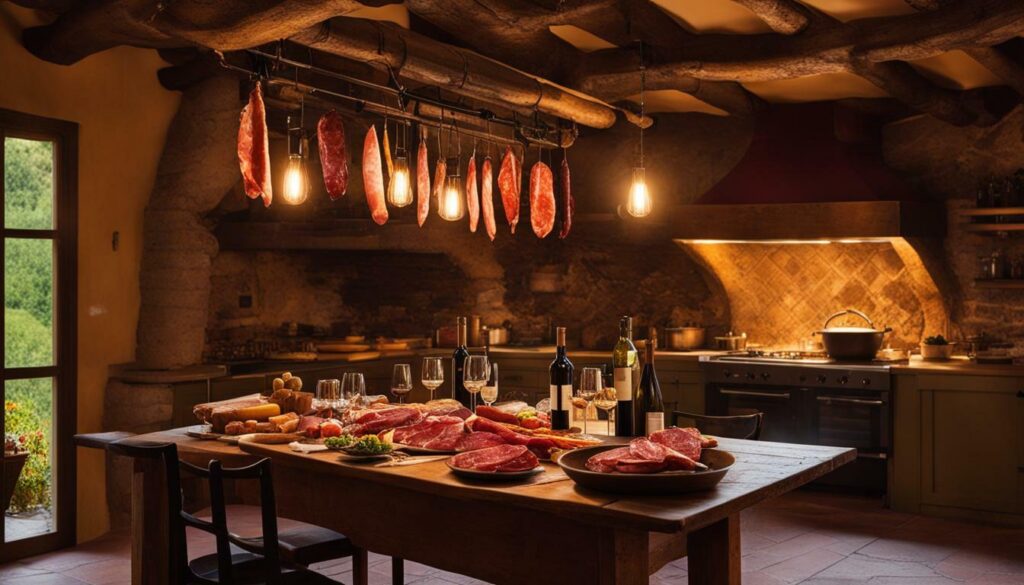
The Impact of New World Discoveries
- The introduction of tomatoes, zucchini, and chocolate revolutionized Italian cuisine.
- Tomatoes became an essential ingredient in pasta sauces and pizzas.
- Zucchini added freshness and vibrancy to Italian dishes.
- Chocolate was transformed into decadent desserts.
| Ingredient | Impact on Italian Cuisine |
|---|---|
| Tomatoes | Became a staple in pasta sauces and pizzas |
| Zucchini | Added freshness and vibrancy to Italian dishes |
| Chocolate | Transformed into decadent desserts |
“The fusion of Old World techniques and New World ingredients during the Renaissance period birthed a new era of culinary creativity in Italy.”
The Renaissance period and the discovery of the New World forever altered the course of Italian cuisine. It brought new and exciting flavours to the Italian kitchen, inspiring generations of chefs to push the boundaries of traditional cooking. Today, we continue to enjoy the fruits of this culinary revolution, savouring the rich and diverse flavours that define Italian cuisine.
Unification of Italy and Regional Flavors
The 19th century was a pivotal time in Italian history, not only politically but also gastronomically, as the distinct flavours of different regions fused together. With the unification of Italy in 1861, the diverse culinary traditions of each region became the foundation of the rich and vibrant Italian cuisine we know today.
The culinary landscape of Italy was shaped by the merging of various regional cuisines, each with its own unique ingredients and techniques. From the rich and hearty flavours of the north, such as risotto and polenta, to the fresh and seafood-centric dishes of the south, such as spaghetti alle vongole and parmigiana di melanzane, every region contributes its own distinct taste to the Italian gastronomic tapestry.
Table: Regional Flavors of Italy
| Region | Famous Dishes |
|---|---|
| Lombardy | Risotto alla Milanese |
| Tuscany | Bistecca alla Fiorentina |
| Naples | Pizza Margherita |
| Sicily | Arancini |
One of the most beloved aspects of Italian cuisine is the emphasis on regional specialities. Every town and city takes pride in its local dishes, often made with locally sourced and seasonal ingredients. This regional diversity not only showcases the wide array of flavours and culinary techniques but also fosters a sense of pride and identity among the Italian people.
Today, Italian cuisine is celebrated worldwide, with Italian restaurants popping up in every corner of the globe. The art of an Italian meal, with its multiple courses and leisurely pace, is an experience that transcends borders and brings people together. From the first antipasti to the final dolce, each dish tells a story of tradition, passion, and the love Italians have for food.

Italian Cuisine Goes Global
From the bustling streets of Naples to the stylish restaurants of London, Italian cuisine has become a global phenomenon, captivating taste buds with its vibrant flavours. The festive foods of Italy are celebrated worldwide, with popular dishes like pizza, pasta, and gelato adored by food enthusiasts everywhere. But the journey of Italian cuisine from its humble origins to its international fame is a fascinating tale of history, tradition, and innovation.
The rich culinary heritage of Italy is rooted in ancient Rome, where ingredients and spices from conquered lands were incorporated into Roman dishes. The Etruscans, Greeks, and Arabs also played a significant role in shaping Italian cuisine, introducing pasta, spices, and fruits that would become iconic elements of the Italian table.
In the Middle Ages, the Arab Muslim occupation of Sicily brought a fusion of flavours to Italian cuisine. New spices and fruits like saffron, citrus fruits, and almonds found their way into Sicilian dishes, creating a unique and bold culinary tradition that still thrives today.
The Renaissance period marked a turning point for Italian cuisine, as increased communication and cultural exchange led to the introduction of foods from the New World. Tomatoes, zucchini, and chocolate became integral components of Italian dishes, forever changing the flavour profiles of traditional recipes.
| Festive Foods in Italy | Popular Foods of Italy |
|---|---|
| Panettone | Pizza |
| Pandoro | Pasta |
| Torrone | Gelato |
As Italy unified in the 19th century, the distinct flavours of different regions became part of the nation’s culinary identity. The diverse regional cuisines of Italy, from the seafood-focused dishes of coastal regions to the hearty pasta dishes of the north, showcase the country’s rich gastronomic tapestry.
Today, Italian cuisine continues to evolve while maintaining its traditional roots. Modern innovations and trends, like the farm-to-table movement and the exploration of regional specialities, add a contemporary twist to classic Italian recipes. With an emphasis on fresh, seasonal ingredients, Italian cuisine not only delights the taste buds but also promotes a healthy and balanced lifestyle.
The Vibrant Flavors of Italy
“Italian food is all about ingredients, and it’s not fussy and it’s not fancy.” – Wolfgang Puck
- Traditional Italian dishes are known for their simplicity, allowing the quality of the ingredients to shine.
- Fresh tomatoes, aromatic herbs, creamy cheeses, and robust olive oil are staples of Italian cooking.
- From the rich and creamy risottos of Northern Italy to the fiery and spicy dishes of the South, Italian cuisine offers a diverse range of flavours.
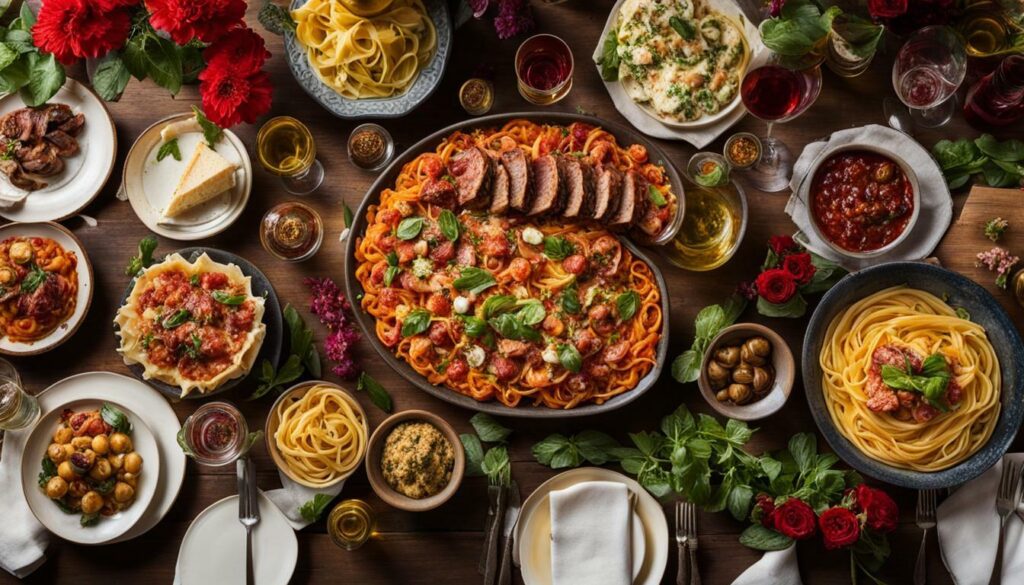
Italian cuisine truly has something for everyone, whether you’re craving a comforting bowl of pasta or indulging in a sweet cannoli. Its global popularity is a testament to the timeless appeal of its flavours and the joy it brings to those who savour its delights.
| Italian Festivals and Their Foods | Popular Festive Foods |
|---|---|
| Carnival (Carnevale) | Frittelle |
| Easter (Pasqua) | Colomba |
| Christmas (Natale) | Panettone |
Traditional Italian Recipes
Embark on a culinary journey through Italy’s traditional recipes, where each bite encapsulates the rich cultural heritage and passion of Italian cuisine. From aromatic pasta to succulent meats, here are some famous foods in Italy that have stood the test of time.
Pizza Margherita
Originating from Naples, the Pizza Margherita is a classic Italian dish that pays homage to the colours of the Italian flag. Topped with fresh tomatoes, mozzarella cheese, and basil leaves, this simple yet delicious pizza represents the essence of Italian cooking. It is said to have been named after Queen Margherita of Italy, who fell in love with the flavours of this pizza during a visit to Naples in 1889.
Risotto alla Milanese
Hailing from the northern region of Lombardy, Risotto alla Milanese is a creamy and flavorful rice dish that is traditionally made with saffron. The golden hue and aromatic taste of this dish make it a standout on any Italian menu. It is often served as a main course or as a side dish alongside Osso Bucco, a braised veal shank.
Tiramisu
No list of traditional Italian recipes would be complete without mentioning Tiramisu. This beloved Italian dessert layers coffee-soaked ladyfingers with a luscious mixture of mascarpone cheese, eggs, and sugar, dusted with cocoa powder. The origins of Tiramisu are disputed, but it is believed to have been created in the Veneto region of Italy in the late 20th century. Regardless of its origins, this indulgent treat has become a global favourite.
Experience the flavours of Italy’s traditional recipes and savour the culinary treasures that have been passed down through generations. Whether you’re a fan of pasta, pizza, or desserts, Italian cuisine offers a vast array of dishes that are sure to delight your taste buds.
An Image to Tempt Your Taste Buds
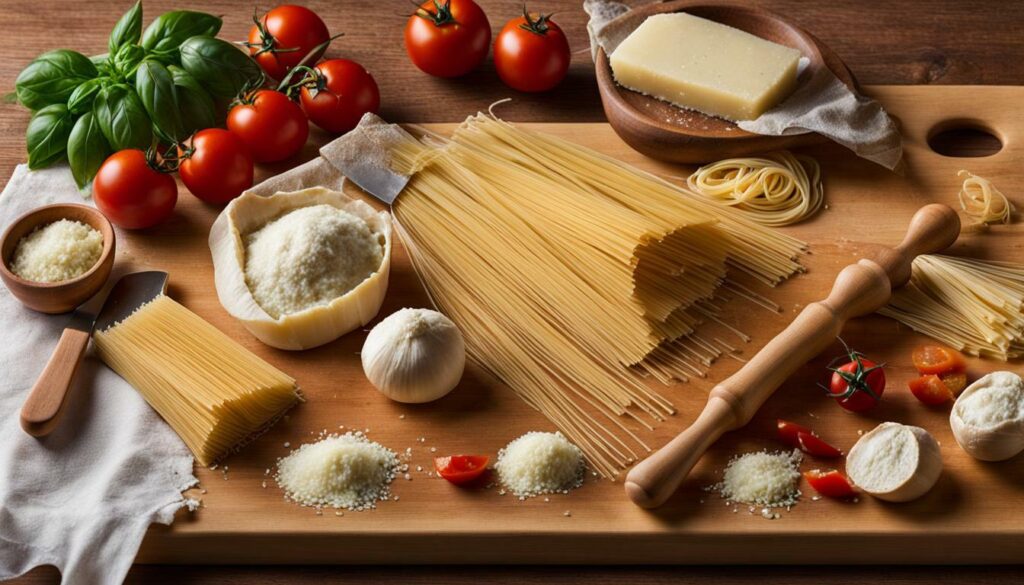
| Famous Foods in Italy | Description |
|---|---|
| Pizza Margherita | A classic Neapolitan pizza topped with tomatoes, mozzarella, and basil. |
| Risotto alla Milanese | Creamy saffron-infused rice dish from Milan, often served with Osso Bucco. |
| Tiramisu | A coffee-soaked dessert with layers of mascarpone cheese and ladyfingers. |
The Art of an Italian Meal
In Italy, a meal is not just about nourishment but rather a carefully crafted experience where each course is savoured and shared with loved ones. The art of an Italian meal lies in the combination of fresh, high-quality ingredients, skilful preparation, and the idea that food is meant to be enjoyed and shared.
Italian meals typically consist of multiple courses, starting with antipasti, followed by a primo, secondo, and dolce. Each course is designed to highlight different flavours and textures, creating a harmonious progression of tastes throughout the meal. Regional variations add depth and diversity to Italian cuisine, with each region showcasing its unique specialities and culinary traditions.
“A good meal is one that starts with hunger and finishes with satisfaction.” – Anonymous
Family plays a central role in Italian culture, and meals are often enjoyed together, providing an opportunity for bonding and connection. Italians take their time when dining, savouring each bite and engaging in lively conversation. The social aspect of an Italian meal is just as important as the food itself, creating an atmosphere of joy, warmth, and celebration.
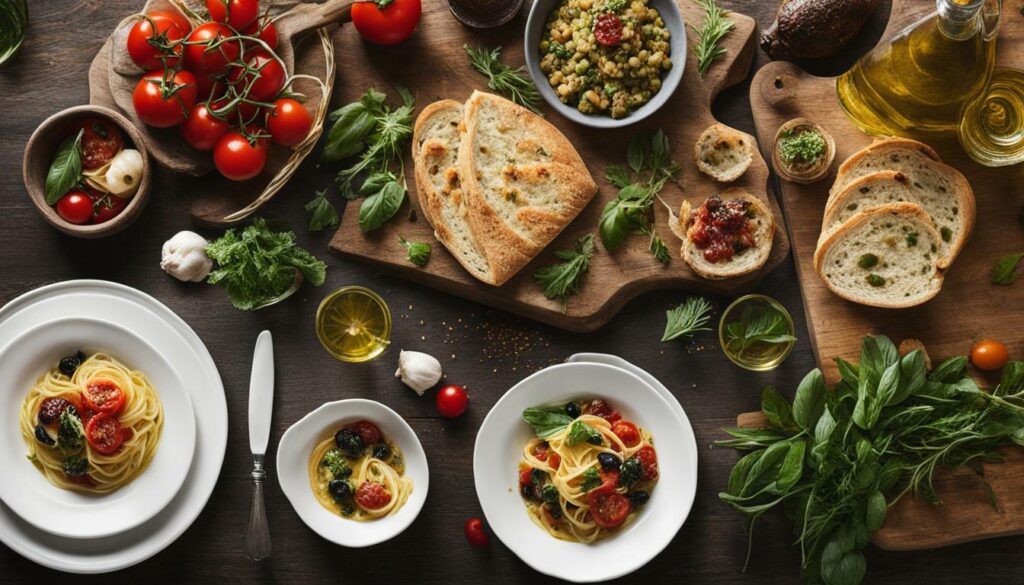
| Course | Typical Dishes |
|---|---|
| Antipasti | Bruschetta, Prosciutto e Melone, Caprese Salad |
| Primo | Pasta, Risotto, Gnocchi |
| Secondo | Grilled Fish, Roast Chicken, Beef Medallions |
| Dolce | Tiramisu, Cannoli, Panna Cotta |
As the saying goes, “When in Rome, do as the Romans do.” So next time you find yourself enjoying an Italian meal, take a moment to appreciate the artistry behind it. From the first bite to the last, let the flavours transport you to the sun-soaked streets of Italy and embrace the joy of sharing good food and good company.
Modern Innovations in Italian Cuisine
Italian cuisine continues to evolve and adapt to contemporary tastes, with innovative chefs infusing traditional dishes with a touch of modern flair. The culinary landscape of Italy is constantly changing, with new techniques, ingredients, and flavour combinations being introduced. From molecular gastronomy to fusion cuisine, Italian chefs are pushing the boundaries of tradition while still honouring the roots of their culinary heritage.
One of the trends in modern Italian cuisine is the incorporation of international flavours and techniques. Chefs are experimenting with ingredients from different cuisines, creating unique fusion dishes that blend Italian traditions with global influences. For example, dishes like sushi pizza and pasta carbonara with quinoa showcase the fusion of Italian and Japanese or South American cuisines, respectively.
Another innovation in Italian cuisine is the focus on sustainability and local sourcing. Chefs are increasingly using organic and locally sourced ingredients to create dishes that are not only delicious but also environmentally friendly. This trend is evident in the farm-to-table movement that emphasizes the use of seasonal produce and supports local farmers and artisans.
| Traditional Italian Recipe | Modern Twist |
|---|---|
| Classic Margherita Pizza | Truffle-infused Margherita Pizza |
| Spaghetti Aglio e Olio | Spaghetti Aglio e Olio with Shrimp and Kale |
| Tiramisu | Matcha Tiramisu |

Italian cuisine also embraces technology in its modern innovations. Chefs are experimenting with molecular gastronomy techniques, using tools like liquid nitrogen and sous-vide cooking to create unique textures and flavours. This blending of science and culinary artistry has resulted in dishes that are visually stunning and provide a multisensory dining experience.
Italian cuisine continues to be a source of inspiration for chefs around the world. Traditional recipes are being reinvented and elevated, while still maintaining the essence of Italian flavours. From inventive pasta dishes to creative desserts, the modern innovations in Italian cuisine showcase the creativity and passion of the chefs who are pushing the boundaries of tradition.
Health Benefits of the Italian Diet
Beyond its delectable flavours, the Italian diet has gained recognition for its health benefits, contributing to the longevity and well-being of its inhabitants. Traditional Italian cuisine, characterized by fresh, seasonal ingredients and a Mediterranean lifestyle, offers a wealth of nutritional advantages.
One key component of the Italian diet is the abundant use of olive oil, which is rich in monounsaturated fats. These healthy fats have been linked to a reduced risk of heart disease and lower cholesterol levels. Olive oil also contains powerful antioxidants that help protect against inflammation and oxidative stress.
The inclusion of a variety of fruits and vegetables in Italian dishes provides a wide range of vitamins, minerals, and fibre. The Mediterranean diet, of which Italian cuisine is a prominent example, has been associated with a lower risk of chronic diseases, including heart disease, certain cancers, and neurodegenerative conditions.
The Health Benefits of Key Ingredients
| Ingredient | Health Benefits |
|---|---|
| Tomatoes | Rich in lycopene, a powerful antioxidant that may help reduce the risk of certain cancers and protect against heart disease. |
| Garlic | Contains allicin, a compound with anti-inflammatory and immune-boosting properties that may help lower blood pressure and cholesterol levels. |
| Whole Grains | Provide essential nutrients and fibre, promoting healthy digestion and contributing to satiety, which can aid in weight management. |
| Fish | Rich in omega-3 fatty acids, which have been shown to reduce inflammation, support brain health, and protect against heart disease. |
| Herbs and Spices | Contain various beneficial compounds, such as antioxidants and anti-inflammatory agents, which can enhance flavour and contribute to overall health. |
“The Italian diet’s emphasis on fresh, whole foods, prepared with care and enjoyed in the company of loved ones, fosters a balanced and sustainable approach to eating. This way of life promotes not only physical health but also mental well-being.”
Furthermore, the Italian dining culture plays a significant role in the health benefits of the diet. Meals are often enjoyed leisurely, allowing for better digestion and a greater appreciation of food. The social aspect of dining, with meals shared among family and friends, fosters a sense of community and connection, which contributes to overall well-being.
In summary, the Italian diet offers more than just delicious flavours. It prioritizes fresh, seasonal ingredients, promotes heart-healthy fats, and incorporates a wide variety of fruits, vegetables, whole grains, and lean proteins. Combined with the Mediterranean lifestyle and the enjoyment of food in the company of loved ones, the Italian diet provides a holistic approach to health and wellness.

Conclusion
The past and present diets of Italy intertwine to create a gastronomic tapestry that celebrates history, tradition, and the joy of shared meals. Italian cuisine has a rich and diverse history, influenced by various cultures and time periods. From the ancient Romans who incorporated ingredients and spices from conquered lands into their dishes, to the Etruscans who introduced pasta to the Italian culinary landscape, the foundation of Italian cuisine was laid.
During the Middle Ages, Sicily’s occupation by Arab Muslims brought new spices and fruits, adding unique flavours to Italian dishes. The Renaissance period further enriched Italian cuisine with the introduction of foods from the New World, such as tomatoes, zucchini, and chocolate. With the unification of Italy in the 19th century, the distinct regional flavours merged to create the vibrant and diverse Italian cuisine we know today.
Italian cuisine has transcended borders and gained global recognition. Traditional recipes continue to delight food enthusiasts worldwide, while modern innovations reinvent classic dishes. The emphasis on fresh, seasonal ingredients and the Mediterranean lifestyle not only pleases the palate but also offers numerous health benefits. The Italian diet is known for its balance, promoting overall well-being.
The culinary heritage of Italy is a testament to the creativity, passion, and love for food that the Italians have cultivated throughout the centuries. It is a celebration of cultural exchange and the enjoyment of meals as a social experience. Whether it’s a plate of fragrant pasta, a mouth-watering pizza, or a delicious gelato, Italian cuisine invites everyone to savour the flavours and embrace the traditions that have shaped it into a global sensation.
FAQ
What is the history of Italian cuisine?
Italian cuisine has a rich and diverse history, influenced by various cultures and time periods. It can be traced back to ancient Rome, where ingredients and spices from conquered lands were incorporated into Roman dishes. The cuisine further evolved with the Etruscans and Arab Muslims, and was later influenced by the Renaissance period, the unification of Italy, and global culinary trends.
When did pasta originate in Italy?
Pasta, one of Italy’s most famous foods, can be traced back to the Etruscans and was influenced by the Greeks and Arabs. However, it became widely popular in Italy during the Renaissance period.
How did Arab Muslim influences impact Italian cuisine?
During the Middle Ages, Sicily was occupied by Arab Muslims, introducing new spices and fruits to Italian cuisine. This influence can still be seen today in dishes such as couscous and citrus-based desserts.
What foods were introduced to Italy from the New World?
The Renaissance period brought increased communication and cultural exchange, resulting in the introduction of foods from the New World. Tomatoes, zucchini, and chocolate are some examples of foods that became integral to Italian cuisine during this time.
How did the unification of Italy impact the country’s cuisine?
With the unification of Italy in the 19th century, the distinct flavours of different regions became part of Italian cuisine. This blending of regional flavours created the diverse and vibrant Italian cuisine we know today.
How popular is Italian cuisine globally?
Italian cuisine is celebrated around the world and continues to evolve while maintaining its traditional roots. It is widely popular and appreciated for its authentic flavours, diverse range of dishes, and emphasis on fresh, high-quality ingredients.
What are some famous traditional Italian recipes?
Traditional Italian recipes are beloved worldwide. Some examples include spaghetti carbonara, lasagna, risotto, pizza margherita, and tiramisu.
What is the importance of an Italian meal?
Italian meals are seen as a social occasion, with importance placed on the art of dining. Courses are typically served in a specific order, and regional variations may exist. Dining in Italy is often a time for family and friends to come together and enjoy good food and company.
How is Italian cuisine being modernized?
Italian cuisine is continuously evolving, with chefs reinventing traditional recipes and incorporating new techniques and ingredients. Modern innovations can be seen in dishes such as deconstructed classics, fusion creations, and innovative flavour combinations.
What are the health benefits of the Italian diet?
The Italian diet is known for its emphasis on fresh, seasonal ingredients, such as vegetables, fruits, whole grains, and olive oil. This Mediterranean-style diet has been associated with numerous health benefits, including reduced risk of heart disease, stroke, and certain cancers.
Source Links
- https://italysegreta.com/exploring-the-history-of-a-meal/
- https://toscanaslc.com/blog/the-cultural-influences-on-italian-cuisine/
- https://blog.windstarcruises.com/history-of-italian-food/



